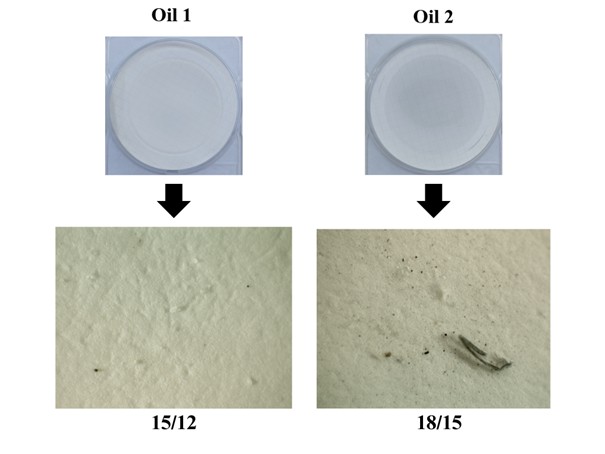Quantitative and qualitative characteristics of industrial oil
Operation in a continuous oil system
DOI:
https://doi.org/10.55225/sti.625Keywords:
industrial oil, continuous oil system, viscosity, impurity content in oilAbstract
The subject of this publication is research carried out on two industrial oils which were used in a continuous oil system, ensuring lubrication of machine elements. In addition, the aspect of the physicochemical properties of the oil and the method of assessing its suitability for operational purposes are discussed. In the paper are presented quantitative and qualitative methods of analysis of industrial oils, according to applicable standards and method of their implementation. The research was carried out over a period of 5 months, so it was possible to determine what parameters of the oils changed during their use. This aspect was the basis for the conclusion on the evaluation of the suitability of the oil as a lubricant in the further operation of the machines. The selected oils that were analyzed differed in purpose, as one of them was a mineral turbine oil and the other a mineral compressor oil.
Downloads
References
Podniało A. Paliwa, oleje i smary w ekologicznej eksploatacji. Warszawa: WNT; 2002. Google Scholar
Lawrowski Z. Technika smarowania. Warszawa: PWN; 1987. Google Scholar
Zwierzycki W. Oleje i smary przemysłowe. Gorlice: Rafineria Nafty „GLIMAR” S.A; 1999. Google Scholar
Makowska M, Molenda J. Oleje transformatorowe – eksploatacja diagnostyka regeneracja. Radom: Instytut Technologii Eksploatacji – Państwowy Instytut Badawczy; 2010. Google Scholar
TOTAL Polska Sp. z o.o. Przemysłowe środki smarne. Poradnik. Warszawa: TOTAL Polska Sp. z o.o.; 2003. Google Scholar
Michałowska J. Leksykon. Paliwa, oleje, smary samochodowe. Warszawa: Wydawnictwo Komunikacji i Łączności; 1983. Google Scholar
PN–EN ISO 6743:2009. Środki smarowe – oleje przemysłowe i produkty podobne (klasa L) – Klasyfikacja. Google Scholar
Migdał E. Olej sprężarkowy – syntetyczny czy mineralny. Polski Przemysł. 2016;9:19–20. Google Scholar
PN–EN ISO 3675:2004. Ropa naftowa i ciekłe przetwory naftowe – Laboratoryjne oznaczanie gęstości – Metoda z areometrem. Google Scholar
PN–ISO 6619:2011. Przetwory naftowe i środki smarowe – Liczba kwasowa – Metoda miareczkowania potencjometrycznego. Google Scholar
PN–EN ISO 12937:2000. Przetwory naftowe – Oznaczanie wody – Miareczkowanie kulometryczne metodą Karla Fischera. Google Scholar
PN–EN ISO 3104:2024–01. Przetwory naftowe. Ciecze przezroczyste i nieprzezroczyste – Oznaczanie lepkości kinematycznej i obliczanie lepkości dynamicznej. Google Scholar
PN–ISO 2909:2009. Przetwory naftowe – Obliczanie wskaźnika lepkości na podstawie lepkości kinematycznej. Google Scholar
PN–ISO 4406:2005. Napędy i sterowania hydrauliczne – Ciecze robocze – Metoda kodowania poziomu zanieczyszczeń w postaci cząstek stałych. Google Scholar
Oleksiak S, Zółty M. Wybrane metody badań do monitoringu środków smarowych. Nafta-Gaz. 2012;11:834–841. Google Scholar
PN–ISO 2977:2012–03. Przetwory naftowe i rozpuszczalniki węglowodorowe – Oznaczanie punktu anilinowego i mieszanego punktu anilinowego. Google Scholar
Drożdż B. Analiza jakościowa związków organicznych. Kraków: Wydawnictwo Uniwersytetu Jagiellońskiego; 2013. Google Scholar
Caesar PD, Sachanen AN. Thiophene–Formaldehyde Condensation. Industrial & Engineering Chemistry. 1948;40:922. https://doi.org/10.1021/ie50461a030. DOI: https://doi.org/10.1021/ie50461a030 Google Scholar
ISO 6614:1994. Petroleum products – Determination of water separability of petroleum oils and synthetic fluids. Google Scholar
PN–ISO 2977:2012–03. Przetwory naftowe i rozpuszczalniki węglowodorowe – Oznaczanie punktu anilinowego i mieszanego punktu anilinowego. Google Scholar

Downloads
Published
How to Cite
Issue
Section
License
Copyright (c) 2025 Dominik Zdzieszyński, Stefania Wasiela, Piotr Niemiec

This work is licensed under a Creative Commons Attribution-ShareAlike 4.0 International License.



